Burma ’44: The Battle That Turned Britain’s War in the East
£7.30£10.40 (-30%)
‘A thrilling blow-by-blow account’ The Times
‘A first-rate popular history of a fascinating and neglected battle… a veritable page-turner’ BBC History
In February 1944, a rag-tag collection of clerks, drivers, doctors, muleteers, and other base troops, stiffened by a few dogged Yorkshiremen and a handful of tank crews managed to hold out against some of the finest infantry in the Japanese Army, and then defeat them in what was one of the most astonishing battles of the Second World War.
What became know as The Defence of the Admin Box, fought amongst the paddy fields and jungle of Northern Arakan over a fifteen-day period, turned the battle for Burma. Not only was it the first decisive victory for British troops against the Japanese, more significantly, it demonstrated how the Japanese could be defeated. The lessons learned in this tiny and otherwise insignificant corner of the Far East, set up the campaign in Burma that would follow, as General Slim’s Fourteenth Army finally turned defeat into victory.
Burma ’44 is a tale of incredible drama. As gripping as the story of Rorke’s drift, as momentous as the battle for the Ardennes, the Admin Box was a triumph of human grit and heroism and remains one of the most significant yet undervalued conflicts of World War Two.
The new, sweeping World War II book from James Holland, THE SAVAGE STORM, is available for pre-order now.
Read more
Additional information
| Publisher | 1st edition (20 April 2017), Corgi |
|---|---|
| Language | English |
| Paperback | 448 pages |
| ISBN-10 | 0552172030 |
| ISBN-13 | 978-0552172035 |
| Dimensions | 12.7 x 2.7 x 19.8 cm |



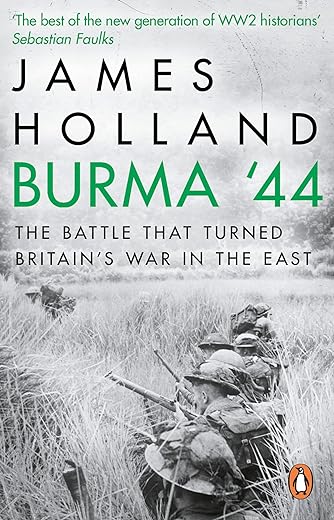
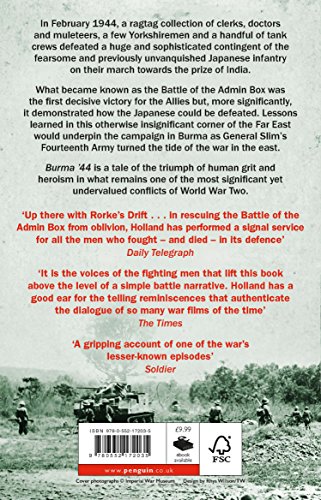
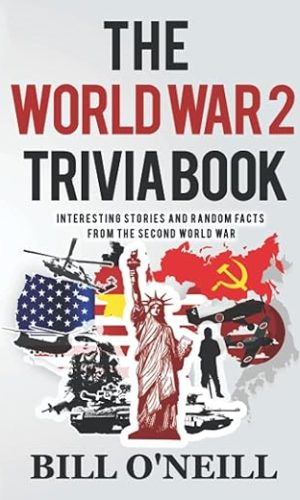
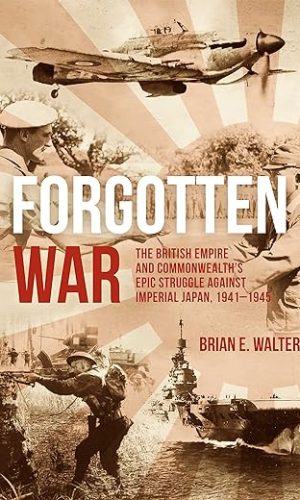

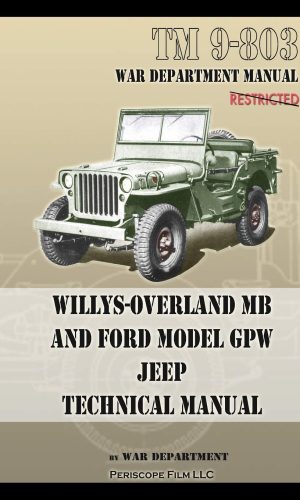
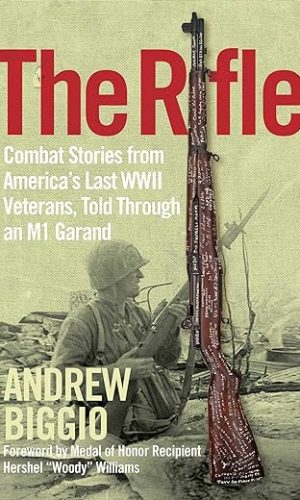
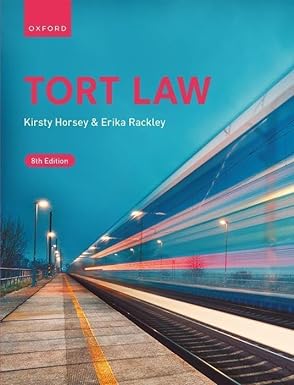
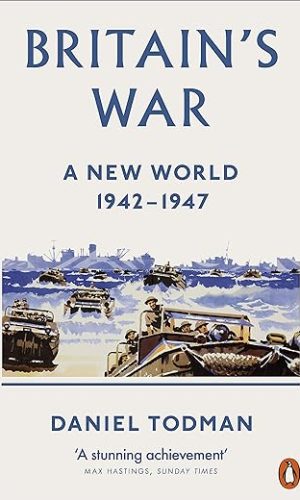
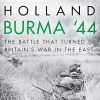
by Joyce
The almost unbelievable state of preparedness in the face of a so far unbeaten Japanese enemy and the slow realisation that they could be held, then beaten. A brilliant read for anyone.
by S
I can’t quite put my finger on it but there is something captivating about World War Two’s Asian theatre – perhaps it is the exoticism, perhaps it is the daunting backdrop, perhaps it is the hot-blooded savagery of a depraved Japanese enemy. Lieutenant General Slim’s 14th are often termed ‘The Forgotten Army’, taking an undeserved second-class seat subordinate to celebrated military endeavours of Normandy ilk, yet the indisputable point remains that Allied Asian continent efforts went some way to eroding preconceived ideas around Japanese military invincibility. English author James Holland journeys the reader to the Allied Arakan Campaign in ‘Burma ‘44’, homing in specifically on the Battle of ‘Admin Box’, a milestone encounter set within a gruelling conflict up to that point dominated by military forces of Imperial Japan.
A hallmark of Holland’s work is extensive use of primary resource in recounting history, Burma ’44 peppered with memoires, diaries and verbal recollection from participant Allied personnel. ‘Through the eyes of the soldier’, ‘boots on the ground’ as authorial blueprints furnish a human feel in that the reader is given greater insight into individual thoughts, feelings, emotions and experiences faced by human beings in acute tribulation. A sense for atmosphere exudes from Burma 44’s pages as Allied soldiers relate minutiae such as jungle sounds, dreaded nightfall and practised Japanese field craft causing relentless feelings of edginess and discomfiture. Burma ’44 then is an immersive experience conducive to engaging us as readers in attempting to grasp both the scale of suffering a conflict as far-reaching as World War Two wrought and support to sole as well as collective outcome for those involved. Holland’s balance of resource utilisation in Burma ’44 is about right: largely a tactical account of a series of engagements or, as another way of putting it, one salient cog as part of the larger strategical Burma Campaign wheel.
From reading other work by Holland, the strategic angle is not in truth a strong suit of the Salisbury historian, perchance attributable to that eagerness to include primary resource, sometimes to excess where names, places and happenings can seem to merge into one. Holland nevertheless outlines a ‘Cast List’ appendix in an atypical but worthwhile approach, with Burma ’44 following experiences of troopers, engineers and senior command thus outlined; the last unusually close to the action by the very nature of encirclement-centric jungle warfare. GOC of the 7th Indian Infantry Division Frank Messervy was exactly one such, after having his HQ overrun going ‘off radar’ for some time in the fallout. In this, Burma ’44 is a mistitle as the aerial view, so to speak, masterfully relayed by Frank McLynn in ‘The Burma Campaign’, cedes precedence in Holland’s book to relatively small-scale, albeit ferocious, keenly contested frays with the Battle for The Admin Box comprising a narrative centrepiece.
With that said, Holland certainly has a gift for descriptive writing in a coruscating, avid, graphic prose. Holland makes logistics as a crucial facet in warfare interesting, another trademark from alternative works on Normandy, the Italian campaign and more general histories of World War Two in the West. Of especial apropos in Burma’s unforgiving environment of mountains, paddy fields, swamps and rainforest, those involved with commissariat and logistics are the real unsung heroes of World War Two and gratifying it is to read Holland paying glowing tribute. But those firing or dropping the projectiles tend to grab the headlines, Holland’s description of battle absorbing and taut in equal measure. If the definition of insanity is doing the same thing over and again expecting a different result, the Japanese evidently played truant through that particular lesson – Holland rationally identifying a tendency to attack through the same means, channels or chaungs notwithstanding prior costly disasters. Be it Leyte Gulf or Midway, The Marianas or Saipan, Imphal or here at the Arakan in Holland’s book, Japanese personnel (drilled and lashed to obedience in World War Two epochs, this proved both a strength and major weakness in Japanese military approach: a strength in following orders to the letter while scoffing notions of backing down; a weakness in that little resourcefulness, initiative or guile could flourish) regardless of service arm, consistently lacked a sound Plan B faced by setback – when the Allies got their collective head around this recurrent manifestation, they began to win the Asian-Pacific War.
James Holland’s Burma ’44 has all the page-turning grip of a novel, giving voice to a sadly Cinderella force truly deserving of all our contemporary gratitude.
by Amazon Customer
as described
by GrumpyUK
As someone who has read Bryan Pereira account of the battle I found this book both informative and well written. As usual with a book written by James Holland it is well researched and brings the reader to the heart of events.
by Nelson
I really enjoyed this book – well written, lucid and comprehensive with regard to the battle he describes – at least from the point of view of the English soldiers involved.
Mr. Holland’s book does great justice to what must have been a miserable battle over an extended period – he conjures up the fear and the stench of the theatre of operations very well indeed and as a result one really begins to understand the extraordinary courage that those involved must of had. Certainly its one of the best books I have read on the challenges, tribulations and struggles of jungle warfare and that includes a raft written on Vietnam.
I also think that Mr. Holland did an excellent job in highlighting the evolution of the 14th Army under Slim. He approached this crucial subject with brevity and clarity with regard to the bigger picture and was then able to weave into the narrative how that effected the situation on the ground, be that around logistics, management of disease, tactics, morale etc. This made the battle very immediate and helped my understanding as to why we must now consider it as one of the crucial encounters of the war.
It is also refreshing to read about successful tactical innovation, be that in the use of combined arms at the same if not a more effective level than seen in the Western and Eastern Fronts, the value of training of men as infantry first and foremost to take into account the fluid nature of battle in Burma and the application of resources at hand, such as the invention of parajutes. All good stuff.
Taken all together, when reading a history such as this it is clear that the changes that Mountbatten, Slim and others wrought from late 1943 onwards were spectacular – was there any other command, on any side, in any other theatre who achieved so much, with so little, while preserving the lives of their men to such an exceptional degree in what can be only described as truly challenging circumstances?
However, I do have three, slightly more circumspect observations – first, yet again the maps provided disappointed; Second it would have been splendid to have heard from Indian, Gurkha and Japanese participants (although the lack of available first hand accounts is hardly Mr. Holland’s fault) and third, the book just felt incomplete.
It is this last point which frustrated me most – it would have been terrific if Mr. Holland had “book ended” better by elaborating more on the Grand Strategy of both sides, then taken us through Arabian (as he did so well) and then finished with Imphal and Kohima – as many of the participants Mr. Holland introduced us in Arakan also fought in the later battle there would have been a satisfying sense of continuity.
In short, a great book and it really would have been a pleasure to read more of Mr. Holland’s excellent prose on what is a fascinating, critical yet generally poorly researched and recorded campaign.
by HJ
I found it near impossible to put this book down. For those of us who lived during WW2 it is a reminder of the honour and thanks which are due to those who fought for our freedom and is a story that the children of the many nations involved should hear and hopefully learn from.
by Alice May
I read this book twice
by Colin James
As per usual with James the book is obviously well researched, it flows very well and kept my interest throughout. I have read very little about World War 2 in the far east but this book has ignited my interest in the subject. I would reccomend this book and any other written by James Holland they have a qualitative edge.